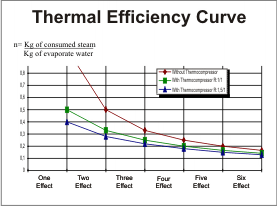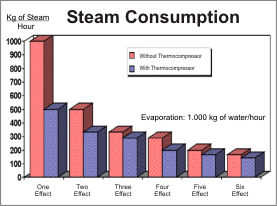In order to determine the optimum design conditions, a large number of factors must be taken into account in order to obtain the equipment that would have an optimum relationship between evaporation performance, economy and quality of the product.
These factors can be summed up as follows:
This type of evaporators is the most widespread in the food industry due to the operational and economical advantages. These advantages can be summed up as follows:
High efficiency, economy and performance
High operative flexibility
High heat transfer coefficients
Capability to work with thermo-sensible products or with tendency to suffer partial or total deterioration
Quick and simple cleaning (CIP)
In these evaporators the feed is introduced on the superior equipment, which has been normally pre-heated at boiling temperature of the first effect, through heat exchangers adapted to the product.
The product is homogeneously distributed inside the tubes in the upper part of the evaporator, generating a falling film of equal characteristics in all tubes. Therefore a lot of care must be taken in this point, since an insufficient wetting within the tubes may produce possible sites where the process is not properly done. This leads to low evaporation efficiencies, premature fouling of the tubes or even the obstruction of them.
Within the tubes a partial evaporation is produced, and the product being concentrated, remains in close contact with the vapor that is generated. Both fluids have equal flow direction and they are conducted in such a way that they come out through the lower end of the tubes.
In the lower section of the evaporator it is produced the separation of these two phases. There the concentrate is eliminated through pumps and the vapor is sent to the condenser (single effect), while the multiple effect systems consume, as a heating medium, the vapor generated in the previous effect. Therefore the generated vapor in the last body is the one that is sent to the condenser.
As an example, it can be said that, feeding a single effect evaporator with 1 kilogram of live steam, approximately 1 kilogram of evaporated water is obtained. On the other hand feeding a double effect evaporator with the same amount of water (1 kilogram), 2 kilograms of evaporated water are obtained, one from each effect. It is concluded then, that the more the effects, the bigger will be the efficiency of the evaporation, thus obtaining excellent relations between live steam consumed per kilogram of evaporated liquid (See picture 1).
Another way of increasing the performance of the evaporator is to install a vapor thermo-compression system. Presently, this is a widespread option, in which the generated vapor is compressed by high-pressure vapor. A significant increase of the heating power of the resulting vapor is achieved in this way. For high evaporation capacities mechanical compression is generally employed for the same purpose. Reuse of the vapor allows obtaining excellent economies during the operation (see picture 2).
The single effect evaporators as well as the multiple effect has the advantage of being able to carry out its cleaning right after the process and, in this way, economize dead times. With a good cleaning schedule the working cycle of the equipment is significantly increased and the final properties of the concentrated product are kept intact.
In this type of evaporator the feed is introduced in the lower part of the equipment and it climbs up the tubes.
The theoretical principle behind these evaporators is similar to the “siphon effect”. When the feed gets in touch with the hot tubes, evaporation begins. Vapor is gradually generated until it exercises pressure towards the tubes, producing a rising film. This pressure also generates turbulence in the product that is being concentrated, which allows a better heat transfer and therefore the evaporation process.
These evaporators work with high difference of temperatures between the wall and the boiling liquid. It is worth mentioning that the height of the equipment is restricted since the capacity of the vapor to raise the film towards the upper part of the equipment is limited and determines the maximum possible height for the design.
These evaporators allow the recirculation of the concentrate assuring in this way the achievement of the optimum feed flow.
The forced circulation evaporators may not be so economical but are the right choice when the product involved in the evaporation has scaling properties, high viscosities, possibility of precipitations, cristalizations or certain thermal characteristics that impede a natural circulation.
This is equipment where the product is heated through a heat exchanger. The product is then sent to a separator, where the evaporation is carried out thanks to the surrounding pressure, being produced in this way a flash evaporation and therefore a cooling of the product. The circulation speed of the product within the tubes is an essential factor to be taken into account for each type of product.



